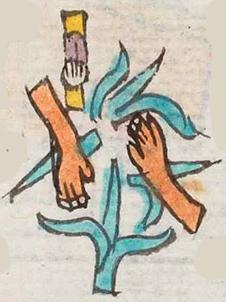Acapolco (Mdz13r)
This compound glyph for the place name Acapolco (also known as Acapulco) consists of turquoise-blue reeds (ācatl) that are being destroyed (poloa) by two human hands. Above and to the left of the plant, which is in pieces, is the tip of an arrow or dart, one that is typically made from the reeds in question. The arrow is yellow and has an eagle feather and a down feather ball attached to it. The hands involved in the act of destroying the plant are colored terracotta. The -co locative suffix is not shown visually
Stephanie Wood
The element of the reed decorated like a dart or an arrow (mitl) is apparently meant to reassure us that this is an acatl reed plant and not some other kind of plant. The hands, maitl, do not have a phonetic role in the place name. But the hands play a role in destroying the plant, making it come apart, involving the verb poloā, to destroy. The verb poloa provides a phonetic clue that the plant is wretched/worthless/old ("pōl," a negative augmentive and functioning as an adjective), according to Gordon Whittaker (Deciphering Aztec Hieroglyphs, 2021, 95–96). See also Karttunen's interpretation (on the right).
Stephanie Wood
acapulco. puo
Acapolco, pueblo
Stephanie Wood
c. 1541, or by 1553 at the latest
Stephanie Wood
If what first catches the eye is the acatl that is like an arrow, then the order begins with downward. But it might begin with the turquoise-colored plant matter and then the hands, where are rather merged.
reeds, rushes, bamboo, arrows, darts, hands, arms, acatl, tules, carrizos, plantas, cañas, nombres de lugares

aca(tl), reed, https://nahuatl.wired-humanities.org/content/acatl
-pol-, wretched (or a pejorative), https://nahuatl.wired-humanities.org/content/pol
poloa, to destroy, https://nahuatl.wired-humanities.org/content/poloa
-co (locative suffix), https://nahuatl.wired-humanities.org/content/co
mi(tl), arrow, darts, https://nahuatl.wired-humanities.org/content/mitl
ma(itl), hand, arm, https://nahuatl.wired-humanities.org/content/maitl
"Place of Worthless Large Reeds" [Frances Karttunen, unpublished manuscript, used here with her permission.]
"At the Big Old Reeds" (Whittaker, 2021, 95); "In the Place of Destroyed (or Tall) Reeds" (Berdan and Anawalt, 1992, vol. 1, p. 168.)
ACA2ACA•pol.
"El Lugar de Cañas Grandes Sin Valor"
Stephanie Wood (based on Karttunen's interpretation)
Codex Mendoza, folio 13 recto, https://digital.bodleian.ox.ac.uk/objects/2fea788e-2aa2-4f08-b6d9-648c00..., image 36 of 188.
The Bodleian Libraries, University of Oxford, hold the original manuscript, the MS. Arch. Selden. A. 1. This image is published here under the UK Creative Commons, “Attribution-NonCommercial-ShareAlike 3.0 License” (CC-BY-NC-SA 3.0).



